What is Tsukemen (Dipping Ramen)?
Tsukemen (dipping ramen) is a type of ramen in which boiled noodles are washed in water and served with a separate bowl of dipping sauce or soup (a bit like zaru soba or zaru udon). Most tsukemen dipping sauces are richer and saltier in flavor than usual ramen soups. They are also sometimes thicker in consistency, and this helps the sauce stick to the noodles when dipping.
Toppings can be placed on the bowl of dipping “soup,” the bowl of noodles, or both, and are basically the same as the toppings served on regular ramen dishes. These often include things like nori, chashu, menma, ramen egg, etc.
In this recipe, however, I specifically make tsukemen with a spicy dipping sauce for a bit of a change.
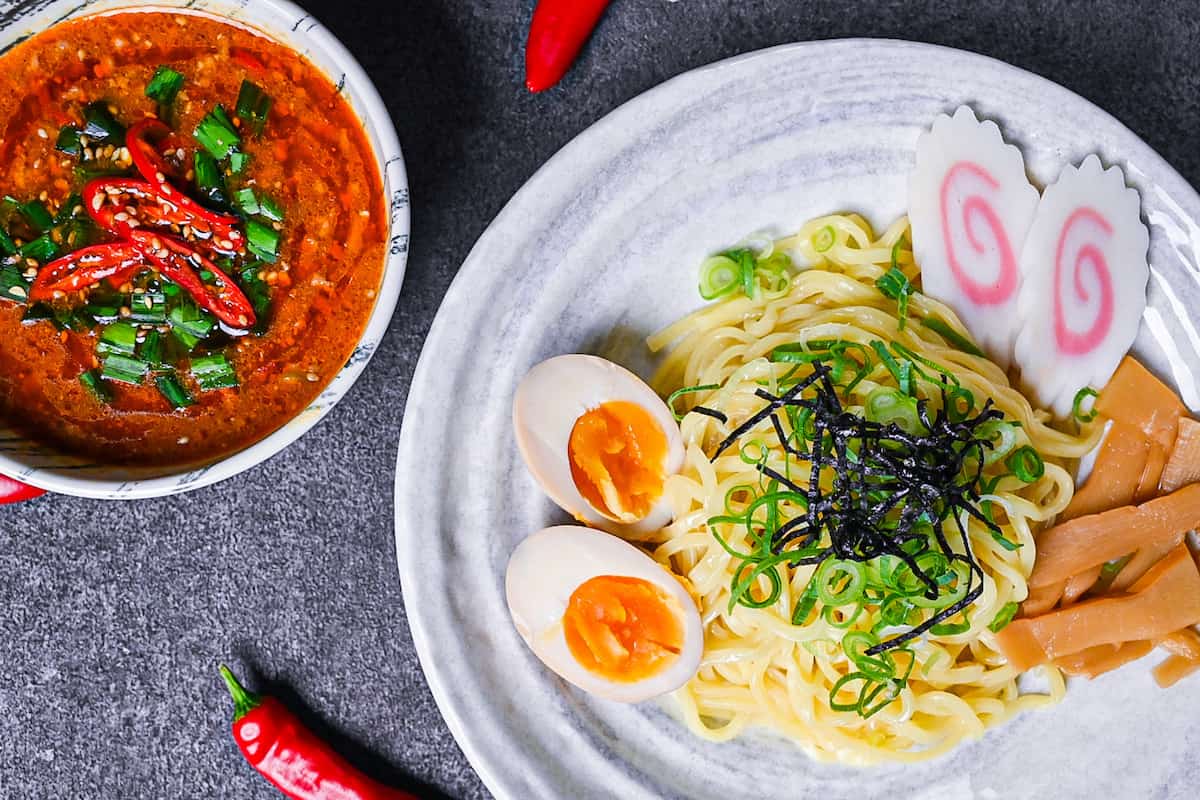

How I Developed This Recipe
It can be tough to make authentic seafood-based dipping sauces for tsukemen at home. These sauces often include a variety of seafood ingredients like fish powders, and the recipes can be quite complex. Plus, the specialized ingredients are often only available in Japan.
Given all this, I came up with a recipe that captures the essence of tsukemen but makes the process a lot simpler. This spicy tsukemen recipe is ready in just 15 minutes, so it’s a quick and tasty version of the classic dish.
Give it a go for a quick and tasty tsukemen experience at home!
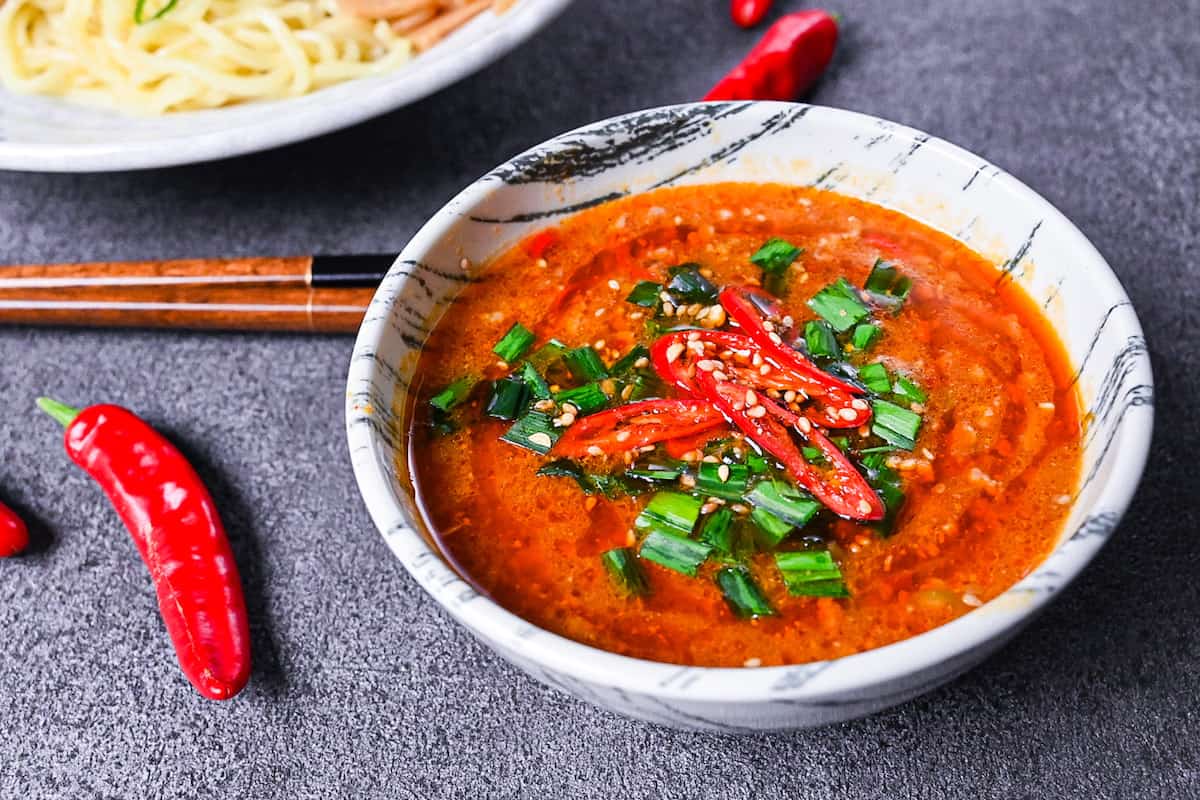
Visual Walkthrough & Tips
Here are my step-by-step instructions for how to make Spicy Tsukemen at home. For ingredient quantities and simplified instructions, scroll down for the Printable Recipe Card below.
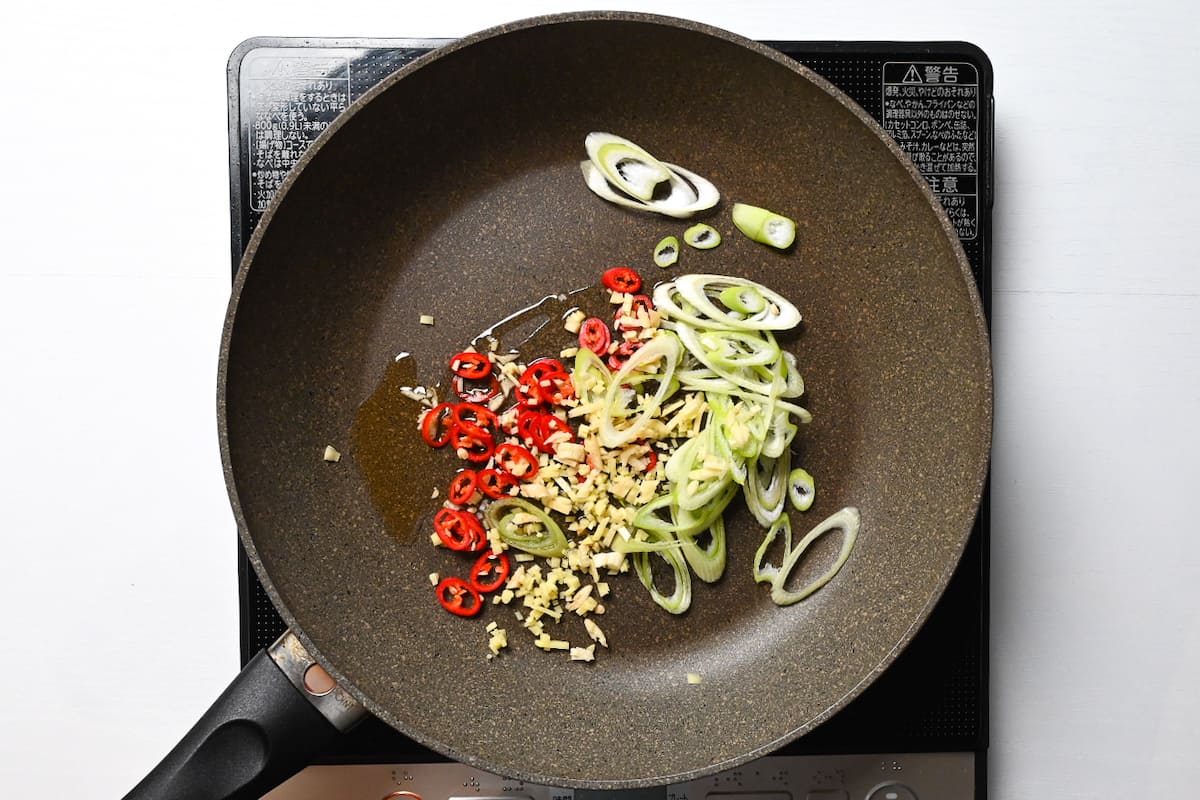
The first step is heating the aromatics to release their full flavor potential. (Cut everything in advance according to the ingredients list in the recipe card below.) Make sure to use a pan or pot large enough to make the soup, we will make the soup in the same pan later.
Start by heating a pan on medium-low and adding some sesame oil. Once the pan is warm, add the garlic, ginger, chili, and green onion; it should sizzle lightly.
Be careful not to use a high heat for this; otherwise, the oil and ingredients might burn and leave a bitter taste. Fry these for a few minutes until you can smell the aromas.
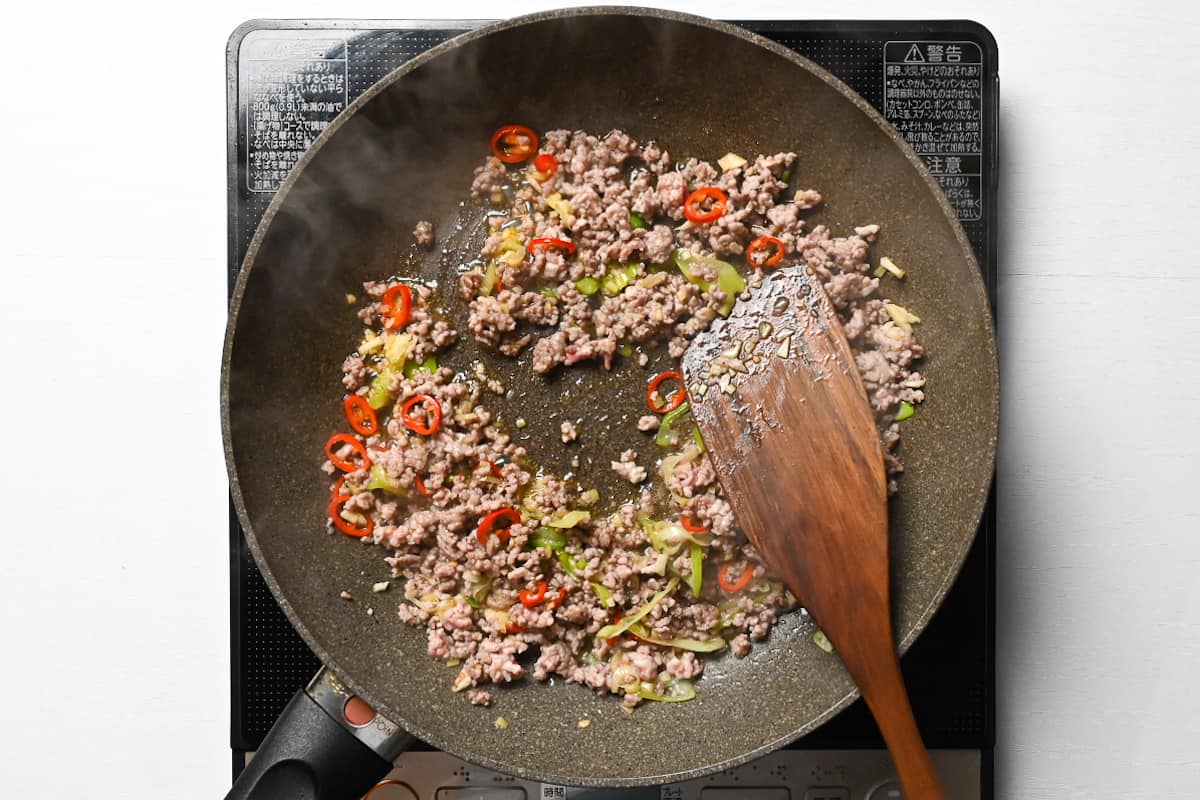
Next, turn up the heat to medium and add the mince. The fat will render out of the meat so there’s no need to add any more oil. Stir fry until the meat is browned.
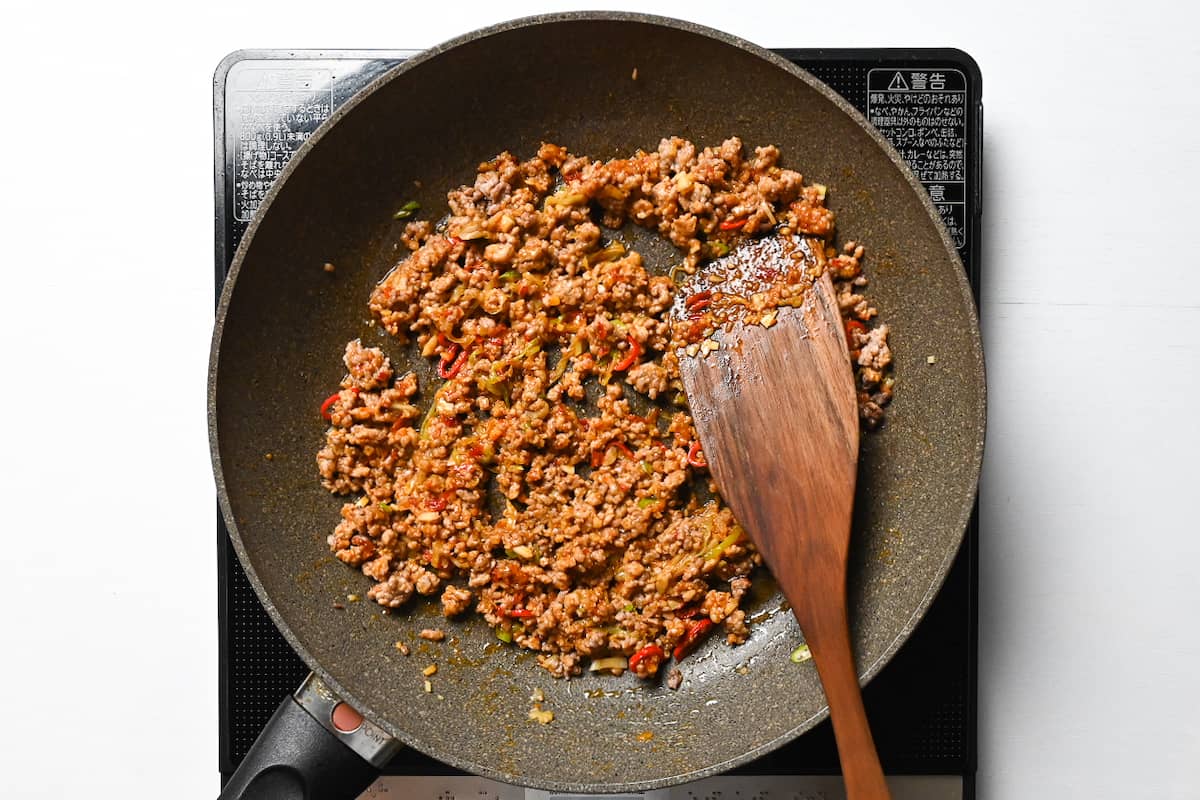
Next, add the miso paste, tobanjan (fermented chili paste), ground sesame seeds, and a pinch of black pepper. Stir fry for 1 minute. The main purpose here is to flavor the meat, but the flavor will also be distributed into the broth!
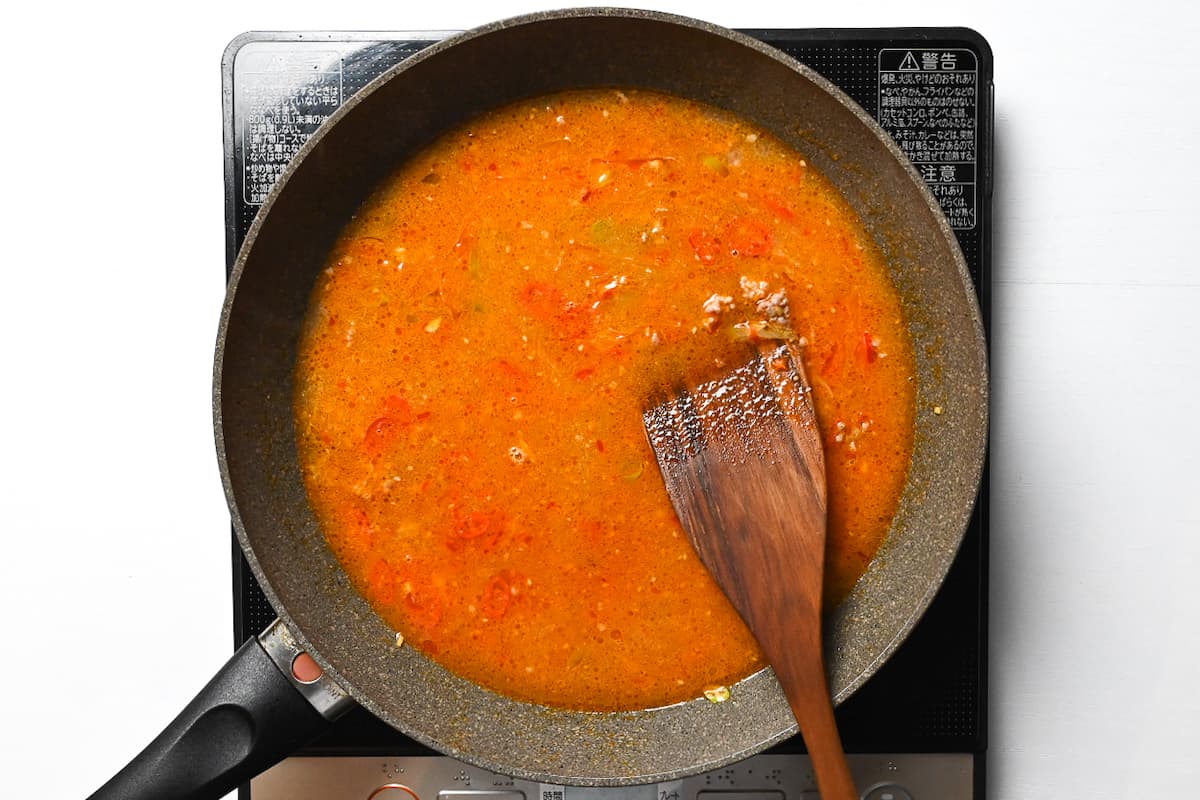
Now it’s time to make the soup! Add water and chicken bouillon powder to the pan, mix it well, and bring it to a boil. Once boiling, turn the heat down to a simmer and add soy sauce and sugar.
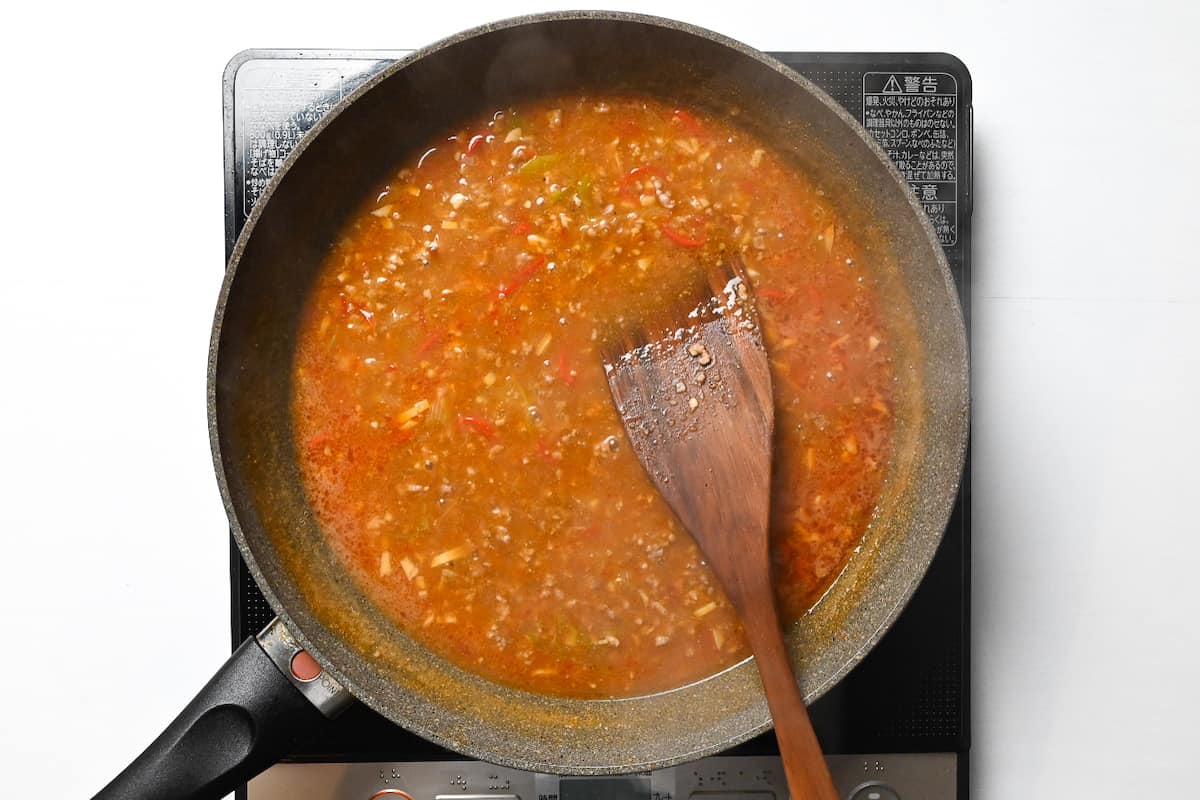
The final step for the dipping broth is to thicken it up. Make a slurry by mixing 1 tbsp of cold water with 1 tsp of potato starch in a separate bowl. Pour the slurry into the pan and continue to stir over the low heat until glossy and slightly thickened.
Never add starch directly to hot liquid. It will clump together and leave gelified lumps in your soup!
Once the soup is thickened, remove it from the heat and place a lid on top to keep it warm.
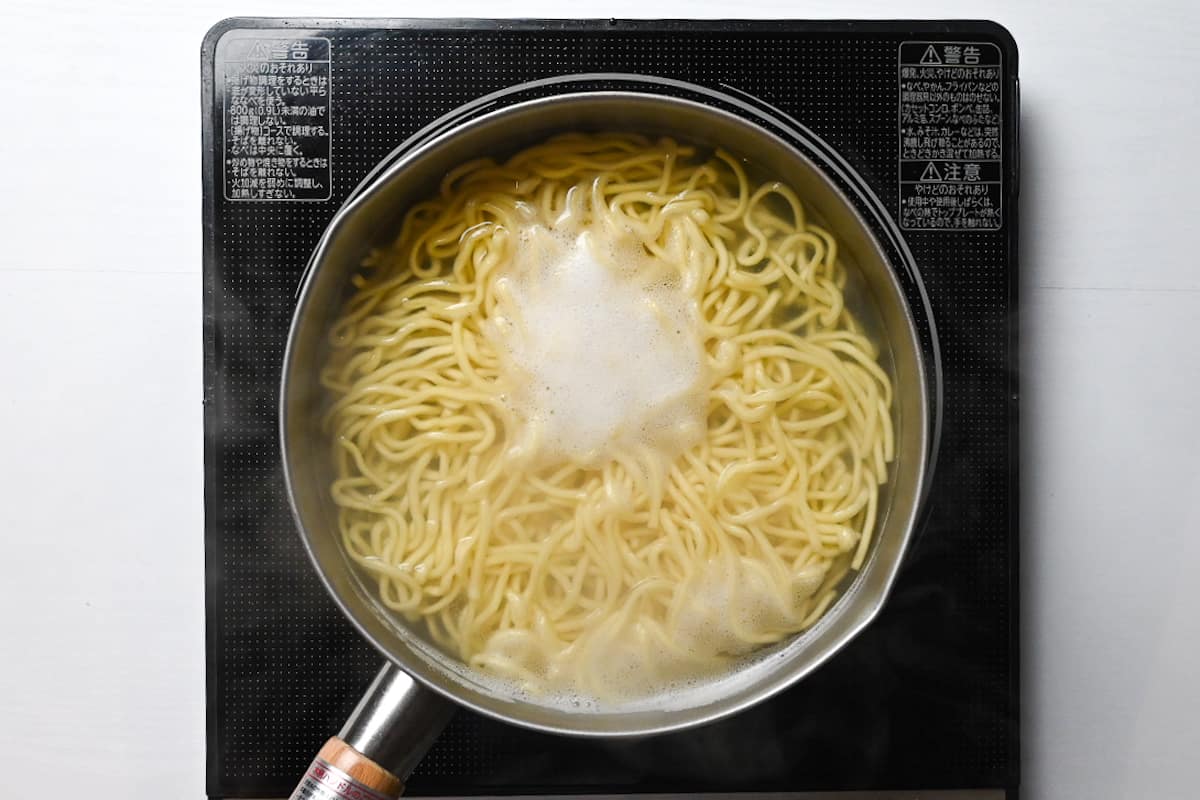
Once your soup is complete, start cooking your ramen noodles according to the instructions on the packaging. The reason we leave the noodles until last is because they’re served separately, there is a high chance of them sticking together.
Here are my tips to prevent ramen noodles sticking together when serving tsukemen:
- Drain using a colander and wash with running water to remove the excess starch
- Place the noodles in a mixing bowl and add a drizzle of sesame oil, mix until evenly coated
- Serve immediately to prevent them from drying out
If you follow these tips you should have the perfect ramen noodles for tsukemen!
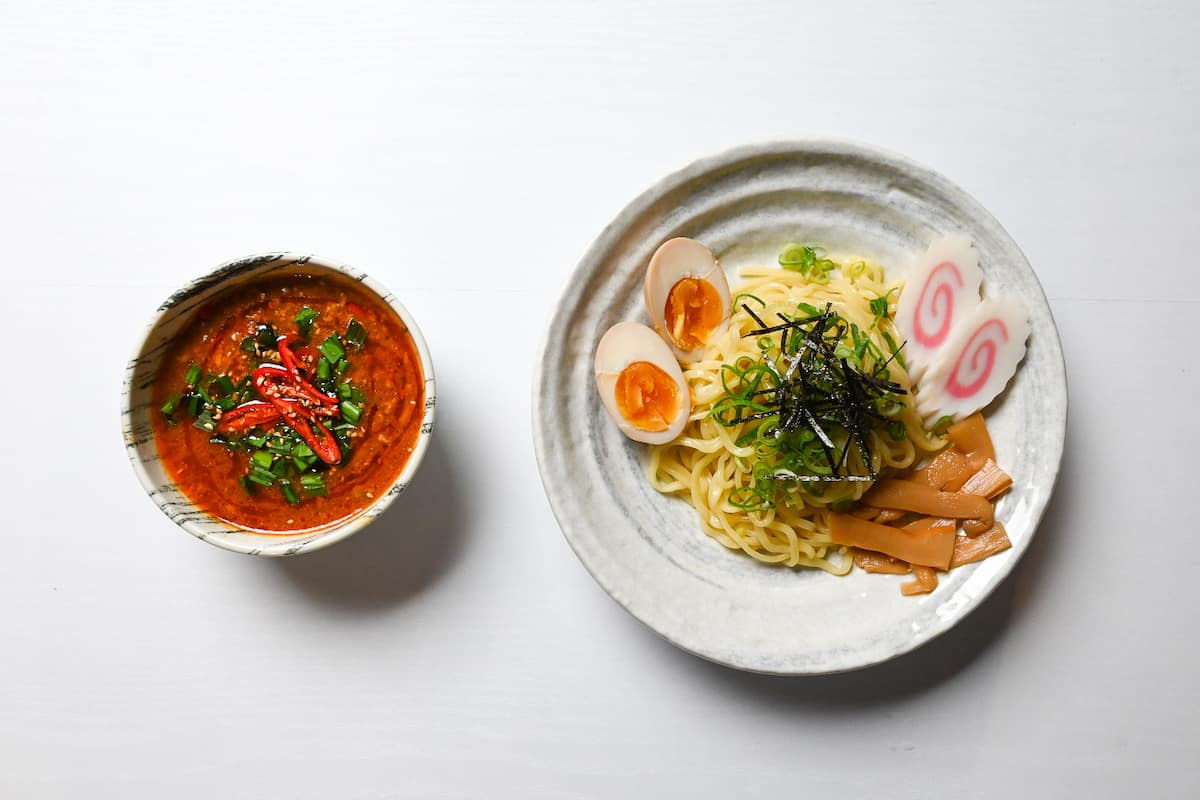
Finally, it’s time to dish up. Place the noodles on a wide plate and top with your ramen toppings. I serve my noodles with naturomaki (fish cake with a pink swirl), menma (fermented bamboo shoots) and ramen egg, then finish it with a sprinkle of chopped spring onion and kizami nori.
The soup should be served on the side in a small bowl. I topped mine with thinly sliced fresh chili, Chinese chives, a sprinkle of sesame seeds, and a drizzle of chili oil. Choose your toppings according to taste!
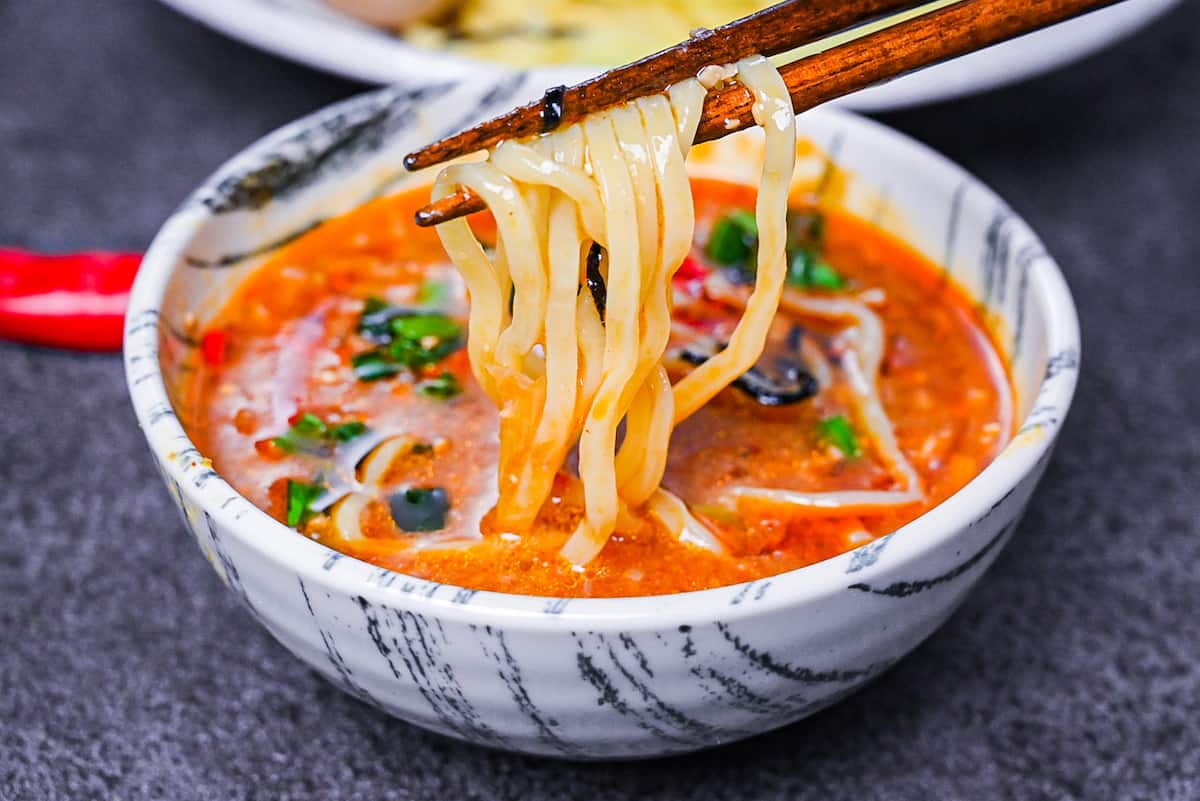
To eat, simply dip the noodles in the soup before eating and enjoy!
Jump to Full Recipe MeasurementsHow to Eat Tsukemen
Long story short, you can just dip ramen noodles in the dipping sauce, but there are certain ways to eat tsukemen to enjoy the fullest.
Shockingly, but not shockingly, tsukemen’s main character is the noodle. The flour used, the shape of the noodles, and other particulars vary from restaurant to restaurant. So true tsukemen lovers taste a little bit of the noodles on their own first.
However, this is not the case for home cooking, so you can skip this step at home.
Typically, tsukemen is served with cold noodles and hot broth. Quickly dip the noodles into the soup and slurp it up in one gulp.
It is recommended to eat roughly three noodles at a time by dipping them quickly into the soup so that the soup will not get cold easily. If the soup gets cold during the meal, you can reheat it if you make this dish at home.
Tsukemen has a thick soup that you can adjust and personalize according to your own tastes as you go. This is done by adding seasonings such as vinegar and chili oil.
The most different way to eat ramen is by doing something called “soup-wari.” The thick tsukemen dipping sauce is diluted by pouring hot dashi into the leftover sauce to drink. It is considered a blissful moment for enthusiasts who want to savor every last bit of the soup.
However, I don’t personally do this step at home, this is more for when you eat tsukemen at tsukemen restaurants. It’s a great option if you still feel hungry though!
Jump to Full Recipe Measurements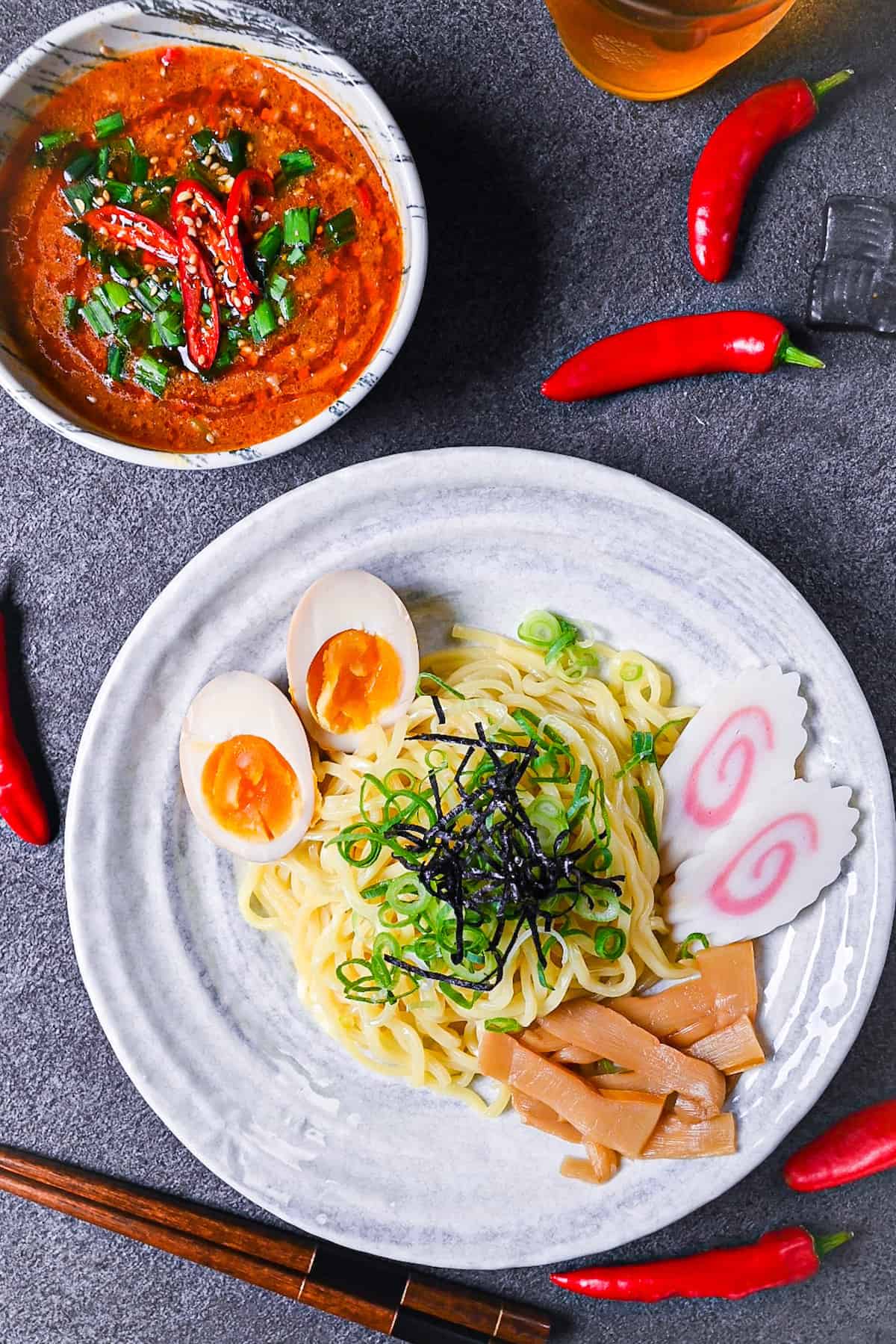
FAQ
There are different theories regarding the history of tsukemen, but the most common theory is that it was created in 1955 by Kazuo Yamagishi, the owner of a ramen restaurant called “Daishoken” located in the Nakano Ward in Tokyo.
It is said that the origin of this dish is by “makanai-meshi (meals for employees),” where leftover ramen noodles served with soup and soy sauce in a bowl were served to workers during the training period. Apparently, a customer happened to see the worker’s meal and asked if they could try it too.
After serving it to the customer and receiving positive feedback, Yamagishi decided to add it to the menu for everyone to enjoy. After various trials and errors, the number of noodles increased by 30%; he named it “Mori soba,” and it became a popular dish across Japan. While the name “tsukemen” is more widely known these days, some restaurants still stick with the original name of “Mori soba.”
Generally speaking, many tsukemen restaurants use seafood base or pork bone (tonkotsu) base broth. While they’re so good, it’s not an ideal choice if you make it at home as it is extremely time-consuming and requires many specific ingredients that can be difficult to find or expensive to use for small batches.
I don’t want to spend a tonne of money and simmer broth for hours and hours to make a few portions of casual tsukemen at home. I may as well go to a ramen restaurant in that case, right?
So, in this recipe, I came up with the idea of spicy and hot tsukemen which can be made within 15 minutes! If you like spicy food, this recipe is for you!
When choosing noodles for ramen, you need to consider which noodles will suit the broth, base of the soup, color, flavor, and intensity of the soup, as well as keep your preferences in mind.
In the case of tsukemen, you need to consider that the soup and noodles are served separately, and the noodles are cooled and tightened with cold water to give them elasticity and a slippery texture.
Since the noodles need to be well mixed with the thicker and richer soup, it is common to use thicker noodles that will not lose against the intense flavor of the broth.
Ramen is a noodle dish generally consisting of ramen noodles in a broth topped with various other ingredients such as chashu pork and menma (fermented bamboo shoots).
Tsukemen, on the other hand, is a ramen dish in which the noodles and soup are served separately, and the noodles are dipped into the soup one bite at a time. This aspect is very much like zaru soba or zaru udon, so you can kind of say tsukemen is kind of like a ramen version of these.
Also, there are generally more noodles in a bowl of tsukemen than there are in a bowl of ramen. The reason is that because the noodles are delivered alone if the amount was the same as regular ramen, the portion would look very small.
As for the soup vs dipping sauce, because tsukemen’s dipping sauce is richer and thicker, you’re not supposed to drink it up (not that you necessarily need to drink up the ramen soup though). This aspect is again very similar to zaru soba and zaru udon.
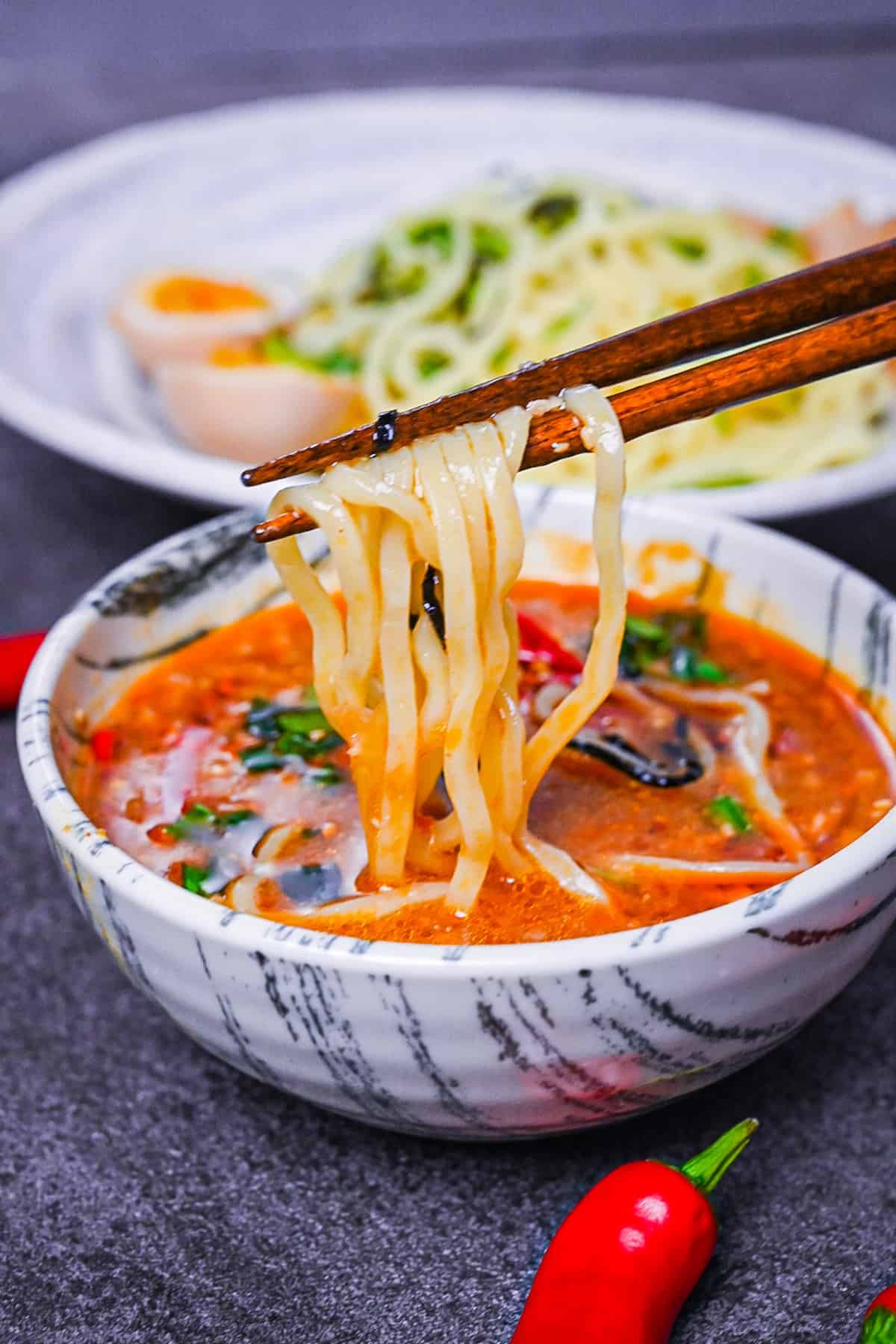
I hope you enjoy this Spicy Tsukemen recipe! If you try it out, I’d really appreciate it if you could spare a moment to let me know what you thought by giving a review and star rating in the comments below. It’s also helpful to share any adjustments you made to the recipe with our other readers. Thank you!
More Ramen Recipes
- 10-Minute Cheat’s Tonkotsu Ramen (No Pork Bones Required)
- Chicken Shio Ramen (Salt Base Broth)
- 15 Minute Spicy Tsukemen (Dipping Ramen)
- Homemade Shoyu Ramen
Want more inspiration? Explore my Ramen Recipe Roundup for a carefully selected collection of tasty recipe ideas to spark your next meal!
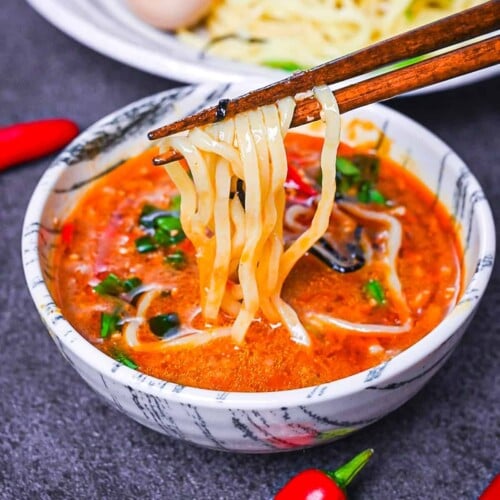
15 Minute Spicy Tsukemen (Dipping Ramen)
Ingredients
For the mince
- ½ tbsp toasted sesame oil
- 30 g Japanese leeks (naganegi) white part, finely diced
- 1 chili pepper dry or fresh finely sliced (red or green)
- 1 clove garlic finely diced
- 1 tbsp ginger root finely diced
- 50 g ground pork
- 1 tbsp chili bean sauce tobanjan
- 1 tbsp yellow miso paste (awase miso)
- 1 tbsp ground sesame seeds
- 1 pinch ground black pepper
For the soup
- 300 ml water
- 1 tsp Chinese-style chicken bouillon powder (granules)
- 1 tsp sugar
- 1 tsp soy sauce
- slurry (1 tbsp water and 1 tsp potato starch)
- 1 tsp sesame seeds to garnish
- 1 dash chili oil (rayu)
- 1 chili pepper red or green, finely sliced to garnish
- 30 g garlic chive(s) nira, roughly chopped to garnish
Ramen noodles and optional toppings
- 2 portions ramen noodles thick
- water for boiling noodles
- 1 tsp toasted sesame oil
- 1 tbsp finely chopped green onions green part finely chopped
- shredded sushi nori seaweed “kizami nori”
- narutomaki fish cake or kamaboko
- seasoned bamboo shoots (menma)
- 2 ramen egg
Instructions
- Heat a large frying pan (it will need to fit the soup later) on medium low and add ½ tbsp toasted sesame oil. Once hot, add 30 g Japanese leeks (naganegi), 1 chili pepper, 1 tbsp ginger root and 1 clove garlic and fry until fragrant.

- Once fragrant, turn up the heat to medium and add 50 g ground pork. Fry until browned.

- Next, add 1 tbsp chili bean sauce, 1 tbsp yellow miso paste (awase miso), 1 pinch ground black pepper and 1 tbsp ground sesame seeds. Mix well and stir fry for 1 minute.

- Add 300 ml water and 1 tsp Chinese-style chicken bouillon powder (granules), then bring it to a boil.

- Once the liquid is boiling, turn down heat to simmer and add 1 tsp soy sauce and 1 tsp sugar.

- In a small separate bowl, mix the potato starch and cold water to make a slurry (1 tbsp water and 1 tsp potato starch). Add the slurry to the soup and cook until slightly thickened, stirring continuously.

- Once thickened, remove from the heat and place a lid on top of the pan to keep it hot until serving.

- Cook 2 portions ramen noodles according to the instructions on the packaging. Once the noodles are cooked, pour them into a colander to drain the water and rinse with warm running water to remove excess starch.

- Transfer the noodles to mixing bowl and drizzle with 1 tsp toasted sesame oil. Mix until evenly coated and then divide onto serving plates. Top each portion with 1 tbsp finely chopped green onions, shredded sushi nori seaweed “kizami nori” and your choice of toppings.Pour the soup into individual dipping bowls and top with 30 g garlic chive(s), 1 chili pepper, 1 tsp sesame seeds to garnish and 1 dash chili oil (rayu).

- Enjoy!

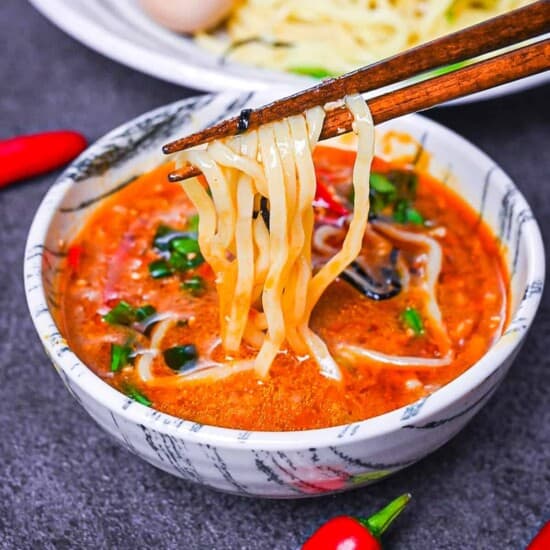




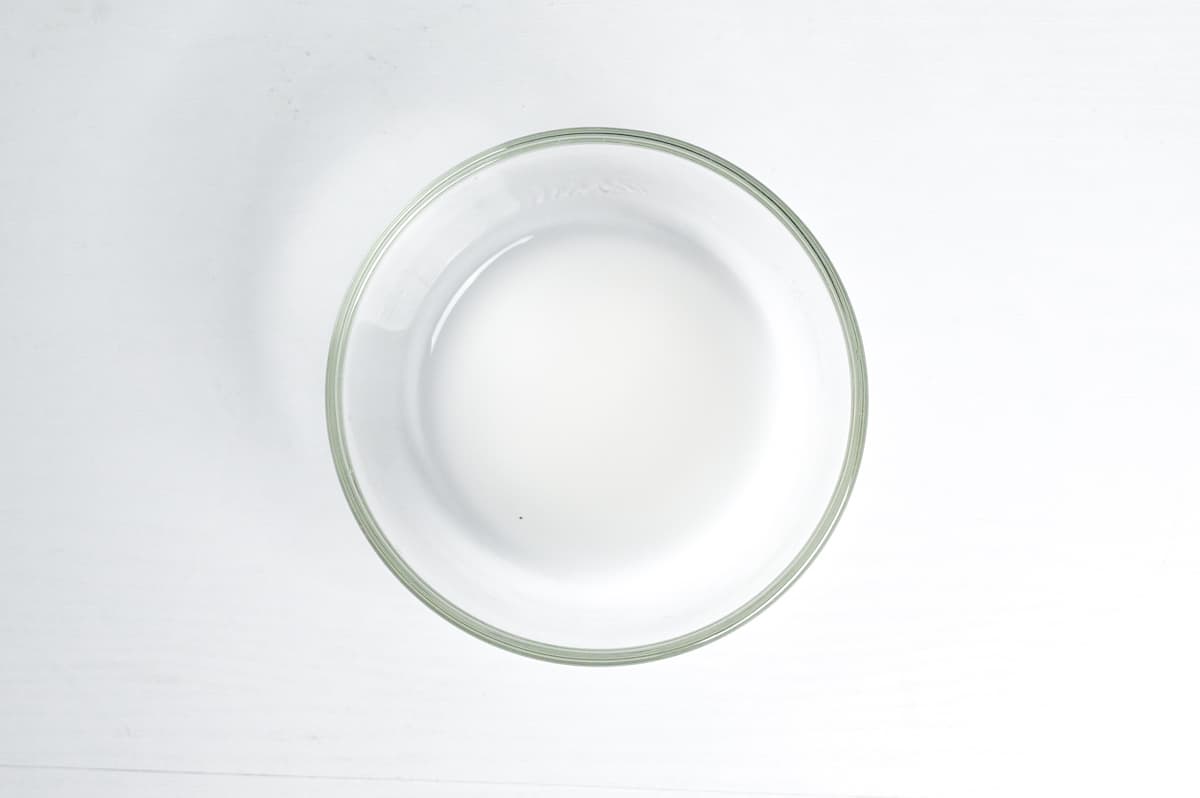
Leave a rating and a comment